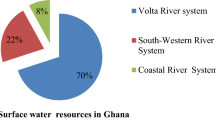Abstract
The study explored and discussed the water management strategy of Istanbul with more than 16 million inhabitants. Istanbul has quite limited local fresh water resources with an ultimate storage capacity of 868.7 million m3 and supplies daily approximately 2.8 million m3 of water at a magnitude of 180 L/ca. 36% of the water demand is supplied from a water source 190 km away from the city. In this study, the critical balance was evaluated accounting for all important factors, population, expansion; water demand; water quality; protection of water resources. The evaluation was specifically conducted in two major water catchment areas around Büyükçekmece and Ömerli Basins between 1994 and 2019 using remote sensing technology. The results outlined a significant increase mainly from bare land and green area to artificial surface in Büyükçekmece and Ömerli Basins with a rate of 217% and 77%, respectively. The conversions to artificial surface were mostly observed to occur in long-range protection zones in both basins. This study also interpreted the potential impacts of the proposed “Canal Project” on water resources regarding the existing and future demands of the population living in Istanbul. The quantitative and qualitative evaluations outlined the fact that the following 5 years of Istanbul will be a critical period in terms of survival and collapse of water management, and that Istanbul needs to enrich its local water resources by generating other alternatives, i.e. sea water desalination from Black Sea or Marmara Sea to compete with the increase of population.







Similar content being viewed by others
References
Alam A, Sultan Bhat M, Maheen M (2019) Using Landsat satellite data for assessing the land use and land cover change in Kashmir Valley. GeoJournal. https://doi.org/10.1007/s10708-019-10037-x
Baatz M, Schäpe M (2000) Multiresolution segmentation-An optimization approach for high quality multi-scale image segmentation. In: Strobl J, Blaschke T, Griesbner G (eds) Angewandte Geographische informations-Verarbeitung, XII. Wichmann Verlag, Karlsruhe, pp 12–23
Çeçen K, Kolay C (1999) İstanbul’un Osmanlı dönemi suyolları (waterways in Istanbul at Ottoman Times). İstanbul Metropolitan Municipality, Istanbul (in Turkish)
Congalton RG, Green K (2008) Assessing the accuracy of remotely sensed data: principles and practices. CRC Press, Boca Raton
Damali A, Belek HT, Orhon D (1989) Water quality management in Istanbul: creating a cleaner environment. Watershed 89:505–514
Definiens (2009) eCognition Developer 8 reference book user guide. Definiens, Munich
Düzce Municipality Annual Report (2018) Annual Activity Report of Düzce Municipality in 2018 (in Turkish). http://www.duzce.bel.tr/resim/upload/8894a.pdf. Accessed 02 Mar 2020
Fichera CR, Modica G, Pollino M (2012) Land cover classification and change-detection analysis using multi-temporal remote sensed imagery and landscape metrics. Eur J Remote Sens 45(1):1–18. https://doi.org/10.5721/EuJRS20124501
Foody GM (2002) Status of land cover classification accuracy assessment. Remote Sens Environ 80(1):185–201
IMM (2009) 1/100000 İstanbul environmental plan and report. Department of Housing and Urban Development, Istanbul
ISKI (2018) Istanbul Water and Sewerage Administration Annual Report, Istanbul Metropolitan Municipality Publications, Istanbul (in Turkish). http://www.iski.gov.tr/web/assets/SayfalarDocs/faaliyetraporlari/faaliyetraporu/pdf/2018%20FAAL%C4%B0YET%20RAPORU%20(1).pdf. Accessed 02 Mar 2020
Islam MR, Abdullah HM, Ahmed ZU, Islam I, Ferdush J, Miah MG, Miah MMU (2018) Monitoring the spatiotemporal dynamics of waterlogged area in southwestern Bangladesh using time series Landsat imagery. Remote Sens Appl Soc Environ 9:52–59
Kasirga E, Kerestecioglu M, Giirdal N, Orhon D (1994) Industrial waste sludge management for the city of Istanbul: a case study. Water Sci Technol 29(9):47–53
Lu D, Mausel P, Brondízio E, Moran E (2004) Change detection techniques. Int J Remote Sens 25(12):2365–2401. https://doi.org/10.1080/014311603
Orhon D (2014a) Istanbul canal needs environmental study. Nature 513(7519):461
Orhon D (2014b) Will the Marmara Sea survive? The struggle against Pollution. Government Gazette, Istanbul
Singh A (1989) Digital change detection techniques using remotely-sensed data. Int J Remote Sens 10(6):989–1003. https://doi.org/10.1080/01431168908903939
TUIK (2020) Official website for address based population registration system in Turkey by Turkish Statistical Institute. https://biruni.tuik.gov.tr/medas/?kn=95&locale=en. Accessed 02 Mar 2020
Tunay O, Germirli F, Meriç S, Orhon D, Gonenç E (1996) Assessment of industrial waste loads in Istanbul watershed areas. Water Sci Technol 34(3–4):79–86
Ulugtekin N, Balcik FB, Dogru AO, Goksel C, Alaton IA, Orhon D (2009) The use of remote sensing and geographic information systems for the evaluation of river basins: a case study for Turkey, Marmara River Basin and Istanbul. J Environ Sci Health A 44(4):388–396
URL 1 (2021) History of water management in Istanbul, Official website of Istanbul Water and Sewerage Administration. http://www.iski.istanbul/web/en-US/kurumsal/iski-hakkinda/history-of-water-management-in-istanbul. Accessed 2 Mar 2021
URL 2 (2021) Official website of USGS earth resources observation systems data center. https://earthexplorer.usgs.gov/. Accessed 5 Mar 2021
Author information
Authors and Affiliations
Corresponding author
Additional information
Publisher's Note
Springer Nature remains neutral with regard to jurisdictional claims in published maps and institutional affiliations.
This article is a part of the Topical collection in Environmental Earth Sciences on “Water Problems in E. Mediterranean Countries” guest edited by H. Gökçekuş, D. Orhon, V. Nourania, and S. Sözen.
Rights and permissions
About this article
Cite this article
Sözen, S., Yüzer, E., Duba, S. et al. Water management for Istanbul: collapse or survival. Environ Earth Sci 80, 289 (2021). https://doi.org/10.1007/s12665-021-09563-0
Received:
Accepted:
Published:
DOI: https://doi.org/10.1007/s12665-021-09563-0




